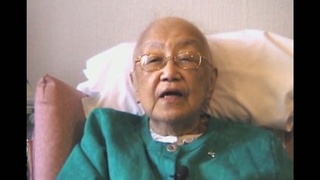Interviews
Picture brides and karifufu
Oh, there’s a funny story. Talk about picture brides and how at that time, many came as karifufu, which is “temporary spouse.” And, my mother, because she was sent back to Japan by her parents, and after she met my father, she wanted to come back to Hawaii to marry him. So, I understand that she came as a couple—she borrowed her younger sister’s fiancé—to come to Hawaii to marry my father. And that’s the karifufu. You see my book. It’s very interesting. They come as a temporary spouse with whoever they want to. And then, of course, they have to share the same cabin, too, you know. But, when they come here, they just separate and go their own way. They apply for divorce.
And for men, it was the stepping stone to go to California because once they step foot on Hawaii, it was easier to go to California. So, for them, it was nothing. And I think, like many, Mrs. Tanimoto also came as a karifufu. And she told me she couldn’t even remember the temporary husband’s name because as soon as they came here, they separated. He went on to the mainland, and she married the Mr. Tanimoto later. So, there were so many divorces. And someone, after seeing my picture bride thing, had written about the divorce rates being higher during that period. But, actually, it’s not a true kind of divorce.
Date: February 19, 2004
Location: Hawai'i, US
Interviewer: Lisa Itagaki, Krissy Kim
Contributed by: Watase Media Arts Center, Japanese American National Museum.












